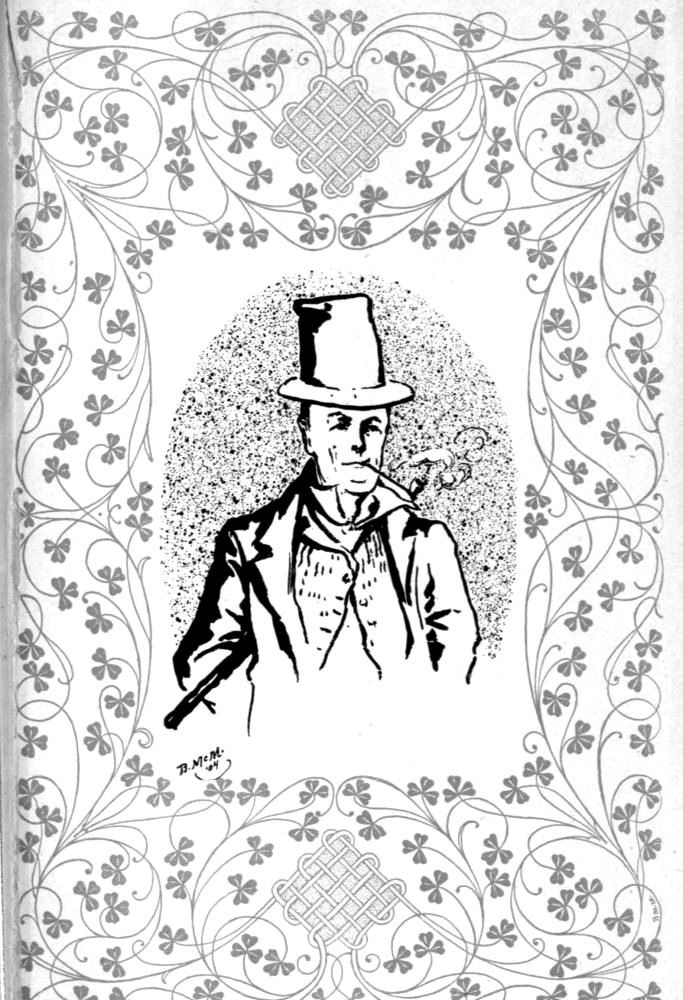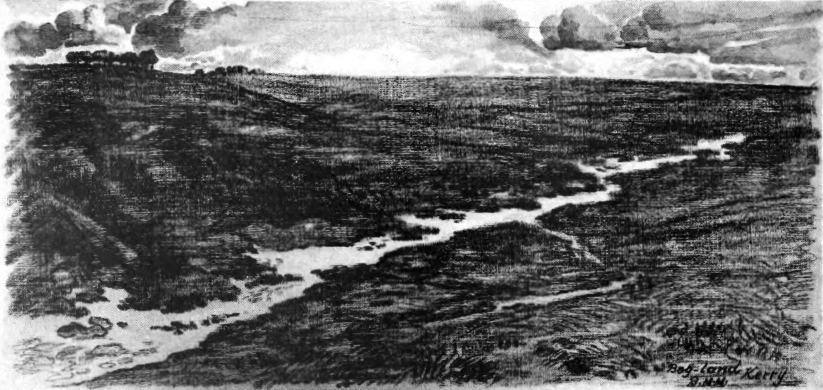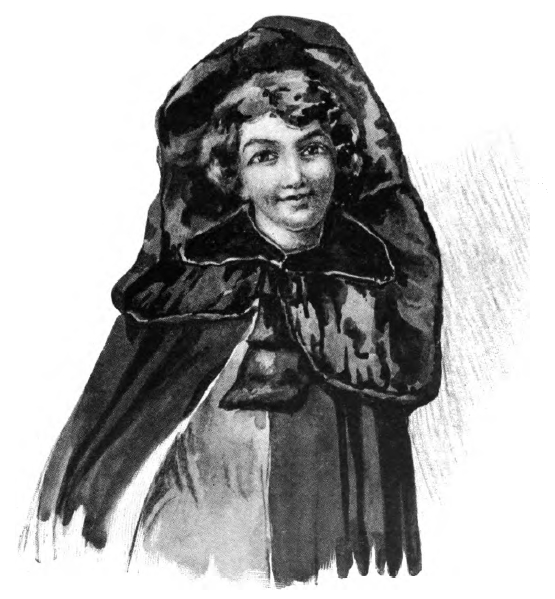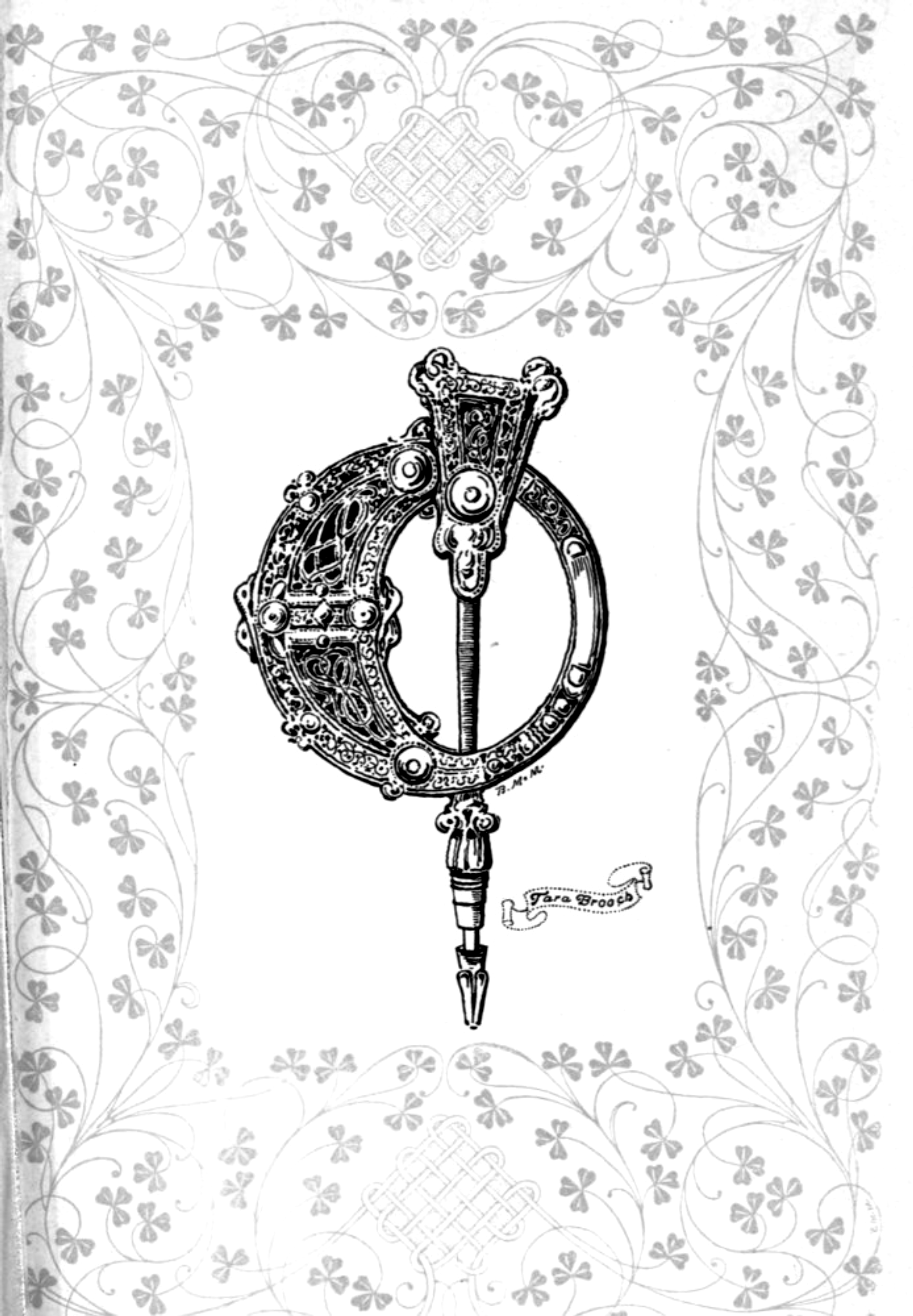| Web
and Book design,
Copyright, Kellscraft Studio 1999-2017 (Return to Web Text-ures) |
 (HOME)
|
|
CHAPTER IV. ROMANCE AND SENTIMENT THE ingredients which most writers on Ireland, the historians, the antiquarians, the political agitators, the publicists, the poets, and, last but not least, the fictionists — from the days of Samuel Lover to George Moore and Bernard Shaw — have used as a basis for their written word have been many and varied. Some have pictured it as a land of desolation and poverty, rich in nothing, while others have descanted elaborately upon its treasures and wealth of historical, architectural, and ecclesiological remains; the beauty of the literature of its native legends; its poetry and music; and erstwhile its native tongue, which may have a latent charm to those versed therein, but which will never become a popular speech, as an Irish member must have hoped when he recently attempted to make a speech therein in the British House of Commons. No one but an encyclopedist could hope to embrace, within the confines of a single work, a tithe of the accessible material which should contribute to the making of an exhaustive work on the subject, and the monumental work is as yet unwritten, and, for aught the present writer knows, unplanned. Perhaps the more interesting detail of any picture which attempts to limn the outline of an Irish landscape, is that which unmistakably indicates the unique character of the inhabitant himself.  The Genuine Irish Peasant There may live an Irishman without humour, without sentiment, without “wrongs;” men and women who marry early, without love, and settle down to a hopeless life of dreary toil, too discouraged to even resent the misery of their lot; but, if so, it is in the pages of the novelist. Those who have in them anything of the real native spirit of youth and courage emigrate, a procedure which, however, deprives the country of much of its soundest raw material. George Moore ascribes this condition to the Irish clergy, who cripple their parishioners with taxes to build unnecessary churches, and who crush out of them all the joy of life by an enforced asceticism. But all that is decidedly another story and quite apart, and is really not so obvious as is at first apparent. The real, genuine Irish peasant is not found, to-day at least, in the pages of the novelist, nor in the verses of the poet, nor in the songs of the opera-house. Tom Moore pictured him with some of the truthfulness of the time, and there is a realization of certain well-recognized local sentiment and colour in “Kathleen Mavourneen.” In the main, however, the joyous Irish peasant, as full of wit as of knavery; the poetic Irish peasant, living in an atmosphere of quaint legend and of charming superstition; the political Irish peasant, member of the Land League, and noble patriot, or treacherous ruffian, according to the attitude which we take toward the Irish question; the romantic Irish peasant, warbling cadences to the faithful girl of his heart, does not exist, — at least he does not in sufficient numbers to project himself into view at every turn, as he does in the comic-opera chorus and the pages of the humourous (sic) Irish tales of to-day. Romance and legend have associated the shamrock, the shillalah, and the dudeen with nearly every mood of Irish fact and fancy; but the casual traveller and seeker after new sensations will see little of any one of these three more or less visionary attributes of the landscape in general. To be sure, if he insists on being brought at once under the spell of the environment which he has pictured to himself as being the one universal accessory of every patch of the “ould sod,” or of every gathering of its inhabitants, he will, if he goes to the right places to look for them, discover the whereabouts of most things of this world’s civilization, of all eras, from the stone hatchet of the ancient Celt, to the motor-bicycle of the Dublin barrister out on a holiday; and from the rancorous peat-bog with its cave-like habitation and straw-bedded floor, to the damask and fine linen of the last joint-stock enterprise of the hotel-keeper, in such advanced centres of progress as Dublin, or more particularly Belfast.  BOG LAND, KERRY. If he takes his standard of judgment from the view-point of food for man, he will find it, in some remote and more poverty-stricken localities, to be something very akin to what he has always believed to be mere fodder for beasts; and again, in the aforesaid luxurious caravansaries, to be the same as that which grace the average tables d’hôte of the great establishments the world over, be they situated in Paris, Vienna, London, or San Francisco. The “Green Isle” is always green, and the native is always picturesque. Sometimes, far away from the centres of population, he is dirty, but not offensively so, at least, not more so than the Italian or Spaniard under similar circumstances. What memories are conjured forth, even to the untravelled, by the mere mention of such places as Killarney, Cork harbour, or Blarney Castle in the south, or Moville, Londonderry, or the Bloody Foreland in the north; and, to specialize for a moment, who among students of history does not give a deservedly high place, among the things of the world beautiful, to the arts of the early builders of Christian edifices in Ireland? In all manner of building, theirs was an art-expression as far above that of the pagan Britons in the neighbouring isle as is possible to imagine. Ireland, indeed, in the sixth and seventh centuries, was the chief centre of Christian activity, of Christian missionary work, and of Christian art in the islands. So strong an influence was this that it is recorded that Irish missionaries went not only afield into England, but even to Italy. The antiquarian and geologist have proved beyond a doubt — what is easy, however, for even the layman to believe — that the Ireland of to-day was originally merely one of the outlying parts of the mainland, and the expression of the customs and arts of the inhabitants of the two at that time did not then differ greatly one from the other. This was maintained, the scholars tell us, through the neolithic and the bronze ages, at which period Ireland came to part company with the mother island. The transition came when the Romans occupied Britain. Roman towns sprang up which had no counterparts in Ireland, and usage and custom developed an entirely new condition of life. Thus Ireland retained a crudity of strength and expression which early evinced itself in its Christian art, and which was added to but slowly. As to what may have been the early religion of the Irish, we are still in the dark. That there were druidical priests seems probable. Legend says that St. Patrick had been a slave in Ireland, having been brought from Scotland, and that even in his days of slavery he formed an affection for the country and its population. The date of St. Patrick’s coming to Ireland, as a bearer of the gospel, is said to have been in the year 430-432, when he returned from Rome after having escaped his bondage. The difficulty is to understand how, at once, Ireland became Christian and, according to the old traditions the “home of Christianity,” and, on that account, called “the Isle of Saints.” St. Patrick’s birthplace is much in dispute, and Armorica, Gaul, Scotland, Wales, England, and Ireland contend for the honour. Much wordy warfare has left the question still undecided, but it is of little moment, since the main facts in the life of this holy man are known, and his devotion to Ireland recognized by all. To come to a latter-day aspect of Ireland, in its relation to world affairs, let us pray that there are signs that the night of hatred and the twilight of suspicion are brightening into a new dawn in partnership between Great Britain and Ireland — into a day of mutual understanding, respect, and, in the end, affection. To realize all that this means, one must understand something of the peculiarities of the Celtic race and their finer traits, even making allowance for their less amiable qualities. To do this, without too great an expenditure of time, one could hardly do better than to digest Justin McCarthy’s recently published book (1903) entitled “Ireland and Her Story.” He will then be, if ever, in a fit mood for appreciation of the lovable and inspiring qualities to be observed in the land itself, no less than in the inhabitants themselves. Mr. George Moore, in his play, “The Bending of the Bough,” has attempted to draw a comparison between the temperament and characteristics of two distinct classes, one resident in a town in the Celtic north of Ireland, and the other in the Saxon south of Scotland. The work is a satire, no doubt, but it shows how widely dissimilar are the majority of the representatives of the two races, and should do much to throw additional light on the subject of the alliance of the two nations. When all is said and done, one comes naturally to the opinion that it was the Irish race, of tradition, at least, that gave the major portion of the romance and fairy-lore to European literature in general — excepting, of course, the sages of the Northland. As Mr. Yeats says, though with a pardonable bias, “Daily life has fallen, for the most part, among prosaic and ignoble things, but in our dreams (we) remember the enchanted valleys.” The modern novelists have given us more than our due share of localized Irish. Mr. George Moore, among all their number, spares us the false, perverted language which some are wont to admire, fondly believing it to be of the earth earthy. For not attempting or perpetrating Irish dialect upon us we should all be grateful to Mr. Moore. In Moore’s books you meet with no such monstrosities as “praste” for priest, “quane” for queen, “belave” for believe, or, worst of all, “yez” for you. Another overworked word in the vocabularies of most writers of Irish fiction or narrative is sure (usually spelt “shure”). Thackeray is supposed to have understood its use better than any other, and as an example one may cite Miss Fotheringay, when she said, “Sure, I made a beefsteak pie.” The “divil” comes frequently to the fore in Irish conversation, or at least there are those who would have us so believe, but its use is more often a perversion than not. It is well recognized that no one laughs so heartily at the attempt to revive the old Irish language as the modern Celt himself. An anecdote has recently gone the rounds that in literary Dublin, which has for its gods Yeats and George Moore, some one has recently made a printed announcement in Erse, but attached thereto, as a sort of sub-section, is a further admonition in the supposedly much hated Anglo-Saxon. An intrepid individual once tried his small store of Gaelic on a native, who replied that he did not speak French, though from his appearance, his age, particularly, he was naturally (sic) thought to be one of those who still spoke the venerable tongue of his race. An Irish automobilist, who had lost his way at a cross-roads because of an enigmatic sign-board, spent much time in roundly cursing the language of his fathers as being entirely worthless and incomprehensible. Many have taken a grim inquisitorial pleasure in showing to a likely Irishman something written in Erse characters and demanding a translation, which, of course, they could not get. Occasionally one sees in the Irish daily papers a picturesque Greek-looking inscription, but few know what it means save the perpetrator, who probably copied it from some old phrase-book. “Ceade mille Failthe” we all know, but there our knowledge ends. All this proclaims loudly the fact that the common people — the middle class, if you like, or what is known elsewhere as the middle class — care and know very little of the motive which inspires the profound scholars of Ireland’s ancient tongue to seek to perpetuate its use. Since, however, Celtic art is the fad of the day, it is but natural that the Celtic tongue should claim some share of attention; but to expect it to make any serious inroads in the national life, or, indeed, in the lives of the “transplanted Irish” of America and elsewhere, is sheer folly. It were easier to have hoped for the success of Volapuk, which, itself, a dozen or more years ago, died of its own sheer weight of consonants. Now that Ireland is supposedly prospering at the hands of a solicitous foster-mother, the “Board of Agriculture,” the demand for Irish products and the interest in Irish art and history are undoubtedly increasing. So, too, the interest in Irish literature, in the abstract; but the Irish tongue itself has a poor chance for popularity. It is well to recall that the mass of the Irish people speak the English tongue alone, a tenth part, perhaps, being able to speak both Gaelic and English, with but a very few who know Gaelic alone. In the south and west the latter is much more spoken than in the north and east, where it is fast disappearing. The Irish Gaelic, or Erse, resembles both the Scottish and the Welsh Gaelic. Some common words frequently met with in travelling about Ireland are:
In the little country towns, where the blue cloaks gather thick upon the platforms of the stations, the musical Irish tongue begins to sound. “To swear in, to pray in, and to make love in,” Irish has no rival among languages dead or living. There are twenty ways and more of saying “darling,” and at least as many ways of sending a man to the devil. When the Saxon coldly orders an enemy to “go to the devil,” the Celt fiercely breathes the wish, “May the devil sit upon your breast-bone, barking for your soul!” and the “Go and hang yourself!” of the Englishman becomes “The cry of the morning be upon you!” — embodying in this brief sentence a detailed wish that the enemy may die a sudden and unprepared death in his bed, and that his relatives, entering in the morning, may find him dead, and shriek over his remains. It is a picturesque and forcible tongue, most assuredly, though one needs a glossary and a thesaurus to correctly estimate the values of these pet phrases. The various blended emotions and sentiments current everywhere in Ireland are the product of tradition in which legend and superstitious belief play an important part. They may not actually enter into every hour of one’s life, but they are ever-present and the supply is bountiful.  AN IRISH LASS. George Moore has said that every race has its own peculiar genius. “The Germans have music; the French and Italians have painting and sculpture; the English have, or had, poetry; and the Irish had and still have their special genius for the religious vocation.” There is no more popular legend or superstition in Ireland, unless it be that of the Blarney Stone, than that referring to St. Patrick’s having driven the snakes from the country. According to the report of tradition, nothing venomous is ever brought forth, nourished, or lives in Ireland. Naturalists do not, however, agree with this. The Venerable Bede evidently believed it, and that the freedom of Ireland from venom was due to the efficacious prayers of St. Patrick. Another authority (Keating) remarks it, and finds it due to a prophecy of Moses that wherever his posterity should inhabit, the country would not be infested with poisonous creatures. The superstition is already hoary with age, but is a perennial topic of conversation and source of argument with the natives in all parts. The literary associations of Ireland are so numerous and of so fresh a character as to suggest the compilation of a great, if not an exhaustive, work on the subject. At any rate, they are too voluminous to record here, even though the geniuses of Swift, of Lover, of Goldsmith, and of Moore stand out as if to compel attention, as they certainly do, in the same convincing manner that Swift’s “Gulliver” influenced a certain Irish bishop, who accepted the tale as the truth, “although not a little amazed at some of the things stated.” Writers on early Irish literature have often overlooked or ignored the fact that, besides the chroniclers of fame and note who indited learned historical works or majestic verse, there are, too, existing poems by various ladies of early Ireland, generally daughters of kings. Another Meave, called the Half-red, has some of the characteristics of Queen Meave herself: “The strength and power of Meave was great over the men of Erinn,” says the introduction to her poem over the grave of her first husband, whom she deserted for a better man; for it was she that would not permit any king in Tara without his having herself as wife. “My noble king, he spoke not falsehood; His success was certain in every danger As black as a raven was his brow, As sharp was his spear as a razor, As white was his skin as the lime. Together we used to go on refections; As high was his shield as a champion, As long his arm as an oar; The house prop against the kings of Erinn sons of chiefs, He maintained his shield in every cause. Countless wolves fed he with his spear, At the heels of our man in every battle.” Ireland’s daughters must have been a glorious and mighty race; indeed, they are so to-day, and one does not need to go back to Moore for endorsement, though he contrasts with marked effect the native elegance of Erin’s daughters with the affected fashionable city belle: “Lesbia wears a robe of gold,
But all so close the nymph has laced it, Not a charm of beauty’s mould Presumes to stay where nature placed it. Oh! my Nora’s gown for me. That floats as wild as mountain breezes, Leaving every beauty free To sink or swell as Heaven pleases. Yes, my Nora Creina dear, My simple, graceful Nora Creina, Nature’s dress Is loveliness — The dress you wear, my Nora Creina.” This was doubtless true enough in Moore’s time, and is so to-day, in spite of the fact that they no longer stand picturesquely around and display their charms in just the manner expressed by the poet. One hears frequent references to the laureate Spenser’s life in Ireland, of his verses in praise of its charms, and of his undoubted love for it, which certainly was as great, if different, as that of Ireland’s recognized “national poet.” Irish sentiment has never allowed recognition to Spenser’s accomplishments, however. The Irish themselves, who are always ready to turn the dull side of the gem toward the light, are not in complete accord on the question of Spenser’s love for Erin, as one will infer from the following, taken from “A Brief Account of Ireland and Its Sorrows:” “Among those who lived here was Spenser, a gentle poet but a rapacious freebooter. His poesy was sweet and full of charms, quaint, simple, and eloquent. His politics were brutal, venal, and cowardly. He wooed the muses very blandly, living in a stolen home, and philosophically counselled the extirpation of the Irish owners of the land, for the greater security of himself and fellow adventurers.” The above is but a note in the gamut, but it is a true one, and it does not ring false, and, while the moral aspect of Spenser’s right to his livelihood in Ireland is left out of the question here, one can but feel that if the Irishman were less emotional and more forgiving much would come to him that he now lacks.  A Brooch from the Hill of Tara |